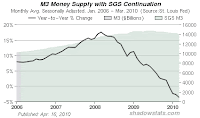Devaluation, referred to as quantitative easing, is not a problem without gold standard constraint. Unfortunately, the margin of safety in terms of the confidence in the dollar is much smaller today than pervious depression. Unlike the 1930's, America has turned from a net creditor to debtor nation. Invisible hand reflects this transition by pushing up stocks, gold, and interest rates despite conventional wisdom that suggests the opposite (falling interest rates). The reason rates rise has to do with confidence (or lack there of) that the debts will be repaid. In other words, rising interest rates reflect the market discounting the risk of sovereign debt default.
Many have observed that the money supply, now buried by the Fed, has been steady contracting since 2009. The continuation of M3, a broad money supply measure, indicates a negative year-over-year contraction. Many observers cite these trends as a precondition of deflation. Quite the contrary, this could be a precondition of aggressive inflation as keenly described in The Mystery of Banking.
When prices are going up faster than the money supply, the people begin to experience a severe shortage of money, for they now face a shortage of cash balances relative to the much higher price levels.
It the Fed's response to the contraction, likely print money money, that will affect confidence in the dollar.
Money Supply with SGS Continuation:

Source: shadowstats.com
Source: mises.org, The Mystery of Banking, p 71
0 comments:
Post a Comment